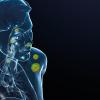Small children may one day avoid invasive oesophageal tube-testing for gut damage and coeliac disease thanks to a new method. It involves blowing into a glass tube to provide effective diagnoses.

In the first study of its kind, Flinders University researchers will trial the new dipeptidyl peptidase-4 (or “DPP4”) breath test in a pilot study to measure a digestive enzyme found in the small intestine, which is associated with gastrointestinal damage and coeliac disease.
Lead researcher Dr Roger Yazbek said the specific DPP4 enzyme is produced in the small intestine and breaks down dietary proteins that have been associated with coeliac disease and associated gut damage.
He said: “This breath test represents a potentially new way to non-invasively measure gut health. Not only will these tests improve patient quality of life, but potentially save the health care system time and money, particularly if adapted for point-of-care testing in rural and remote areas.”
Image credit | Science Photo Library




